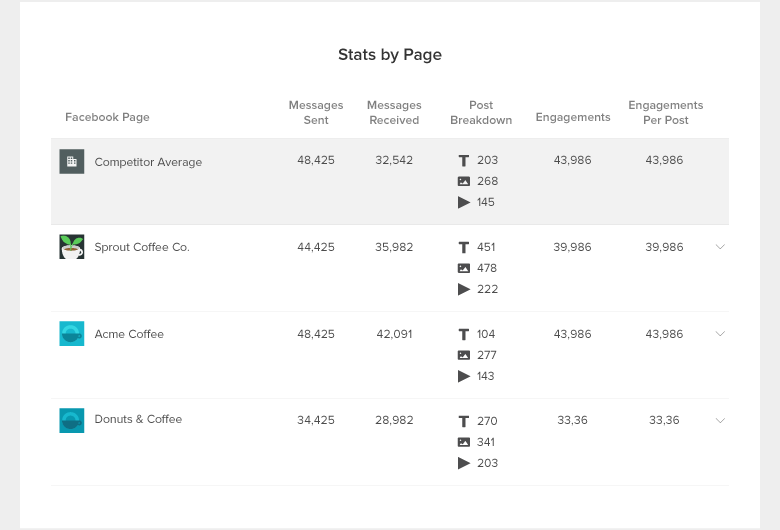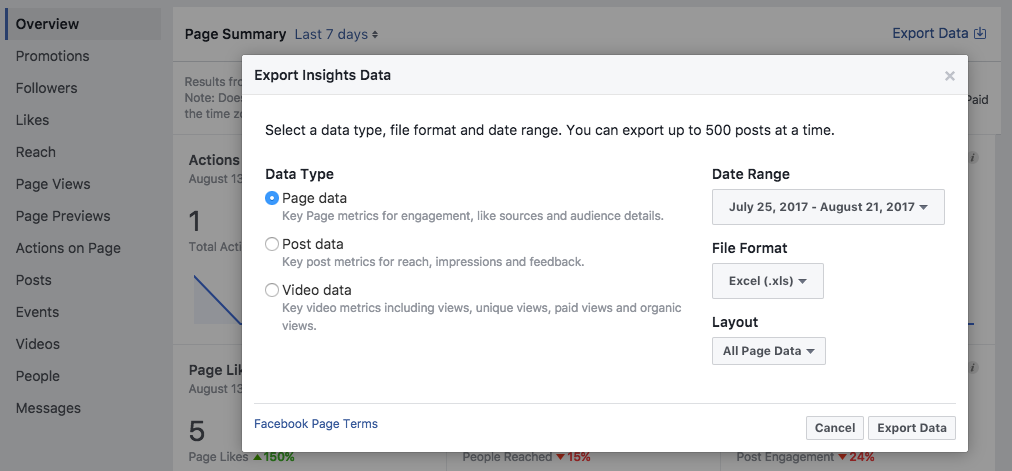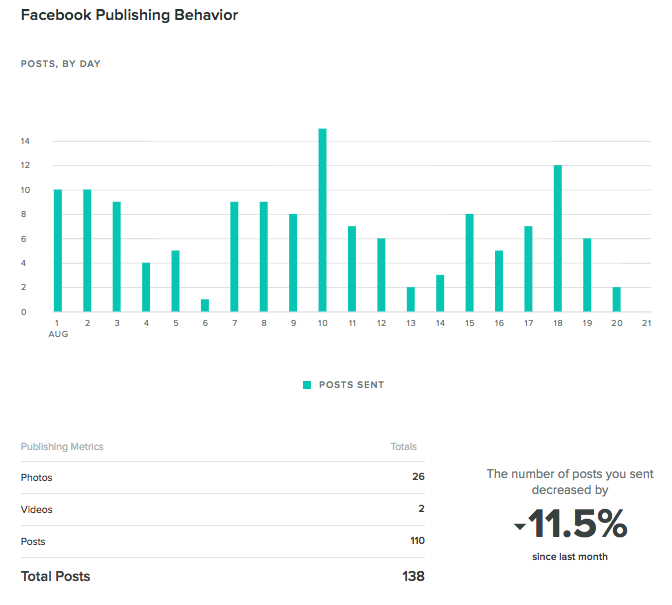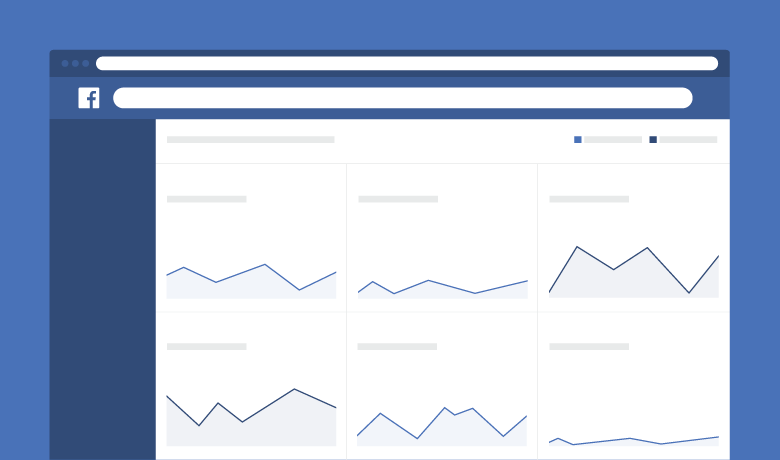Facebook is a preferred social network by marketers, not only because of the sheer number of users represented but also because of its incredibly insightful analytics suite. It’s important to be able to analyze customers and their behavior on a micro level due to Facebook’s ever-changing algorithm, and the implications for your content and business. If you refuse to adapt your approach based on these insights, you’re doomed to obscurity on the news feed.
A deep Facebook analysis shouldn’t be a one and done situation. Ideally, you’ll be auditing your efforts every few months or so at most. But don’t feel guilty if this hasn’t been a part of your social media strategy so far—there’s no time like the present to start a new habit.
Here’s a step-by-step guide on how to conduct a deep Facebook analysis. If you want to follow each step, we suggest using our Facebook Analytics tools. While most of your analysis can be done with Facebook Insights (we’ll show you how to do it with both), Sprout streamlines the process plus gives you some additional reports for more insight.
1. Analyze Your Competitors
The Facebook Insights data attached to your Facebook business page will provide you with a wealth of information, but it’s a good idea to start your Facebook analysis by looking at your competitors.
Find Your Competitors
For this part of your Facebook analysis, there are three kinds of posts that you’ll want to scrutinize for insights: posts related to your industry, your competitors’ posts and your own posts. If you’re not sure who’s your competition, here are a couple strategies to incorporate during your research:
- Find them on Google. Use Google to search for key phrases relating to what you do. If your business is not local, you can use search terms that best describe your industry.
- Look at who your audience follows. Check out the other brands your audience follows on social media and note the most similar to your company.
Analyze What They’re Doing
Once you’ve identified your top competitors:
- Choose the top 3-5 competitors to benchmark your efforts against.
- Gather information about them, including the social networks they use, the size of their following, how often they post and what their engagement numbers are like.
Manual competitor analysis is a tedious process. But with Sprout Social, users have access to our Facebook Competitor Analysis Report. This report shares audience growth numbers, so you can track fan count by day, as well as message volume to see how active the competition is on Facebook.

Perhaps the most useful aspect of the analysis is the message volume chart that includes overall posting volume, a breakdown of post types, total engagement and engagement per post. This data will help you to benchmark your efforts against competitors and may provide some motivation to renew your campaigns on the platform.
Few things are more motivating than the numbers of your competition staring you in the face.
2. Gather Your Data
Now that you have some benchmarks and an idea of what your competition is doing, it’s time for some self reflection. In this step, you’re going to pull data on your brand through Facebook Insights or Sprout Social.
Accessing Facebook Insights is simple: just go to the Facebook Page Manager and click Insights. The default data range displayed on Facebook Insights is 28 days, but you can toggle this to fit your needs.
If you’d like to download the data to analyze or manipulate it off the Facebook platform, click on the Overview tab, then on Export Data. There will be a popup showing three kinds of data types you can export: Page data, Post data and Video data, as well as a data range for when you want your Insights. Our recommendation? Download everything.

What does each export include?
- Page Data shows you key page metrics for engagement, like sources and audience details.
- Post Data provides metrics for post reach and impressions.
- Video Data displays your key video metrics like number of views: unique, paid and organic.
If you don’t want to deal with the process of downloading and interpreting multiple sets of data, you can also conduct your Facebook Analysis with Sprout Social. New users can grab a 30-day free trial without entering credit card information.
In Sprout, after you sign up and connect your Facebook account, you’re going to run a Facebook Pages report.

Once you have all the data in front of you, it’s time to dive deep into your Facebook analysis.
3. Analyze Your Facebook Page Data
Once you’ve gathered all your data, it’s time to dive into the numbers. It’s best to divide this into two different parts. First, we’ll take a look at page level metrics, then we’ll go over analyzing individual post performance.
Before trying to make sense of all this data, it’s helpful to set some key performance indicators (KPIs) that are important to your business. For example, if you’re using your Facebook Page to drive traffic to your website, one of your KPIs might relate to link clicks. However, if you’re focused on building a community, set a KPI for engagement stats.
While there are a ton of metrics you can look at, we’ve trimmed the list down to some of the key metrics we feel indicate strong content and a successful social strategy.

Facebook Likes
This simply refers to the number of people who click the “Like” button on one of your posts. Facebook likes are a clear indicator that somebody is enjoying your social media content. This is a metric that you should always work on increasing, as it shows that people have some basic connection to the content that you’re posting.
The Lifetime Likes tab shows the overall likes for the page in the time period you’ve designated. You can use the data on this tab to identify specific days when likes spiked. Comparing this page data to post data, you’ll be able to identify specific posts that resulted in a good response from your audience, which may correlate to an increase in page likes.
Use the Daily New Likes vs. Daily New Unlikes tab to determine your net number of likes for the day, and to determine the days when you had the most unlikes. You can also cross-reference this with post data to identify which posts do not seem to be resonating with your audience.
Lastly, take a look at the Where Your Page Likes Happen tab to get information regarding from where people ‘liked’ your page. More than likely, no pun intended, a majority of people liked your page directly, but a number of fans could’ve come from other sources such as a Facebook button on your site. Knowing this is useful for connecting your digital marketing efforts across channels.
In Sprout, you can use your Audience Growth report to see how your number of likes trend over time, as well as unlikes. We also break down the data by paid and organic likes.

Engaged Users
Engaged users refer to the number of people who clicked anywhere in your post, without generating a story, plus the number of unique people who created a story about your Page post. This is a great metric to increase because it means people are creating their own unique stories about your posts.
Video Stats
The page data also includes statistics about your video content and how users interact with it.
To access this data, check out the tab for Total Video views (daily, weekly, 28 days), for paid and organic views. There is also a tab with data for Daily Total Number of Times a Video Has Been Seen Again, which is the number of times a video has been played after the initial play. More than one play per person indicates that people have been coming back to your page to see the video.
Another tab to consider in your Facebook analysis is the Daily 30-second Total Views, which shows the number of times a user has viewed a video for at least 30 seconds, with additional data regarding how many people have viewed the end of a video. Both of these metrics are useful in understanding whether or not your content was interesting enough to warrant more than a cursory glance.
Your Sprout report will give you video performance data as well.

4. Analyze Your Facebook Posts
When looking at the performance of individual posts, we’re going to analyze both reach and engagement metrics. Here’s a breakdown of what each includes:
- Post Reach shares basic post statistics like impressions, engaged users, consumption and video views.
- Post Engagement shares basic engagement stats like engaged users, consumption and negative feedback.
Reach
According to Facebook, “Post reach is the number of (unique) people who have seen your post. Your post counts as reaching someone when it’s shown in their News Feed.”
The number of impressions is similar to reach but instead refers to the total views of the post. Of course, both metrics are important to focus on increasing, as the more people you reach, the more potential customers there are seeing your posts.
The algorithm that Facebook uses to decide what to show in each user’s News Feed is known as “Edgerank”, and it’s made up of a handful of different factors. Check out an in-depth look at these factors in our Facebook Edgerank guide. To keep things simple for this topic of Facebook analysis, assume that your posts will gain more reach with an increase in clicks, shares, comments and likes.
Look at the post reach and identify spikes and peaks in the Reach column. You can also see the type of posts that generate these likes, as well as their permalinks (if you want to refer back to the full published post).
You can use Sprout’s Impressions Report to see patterns in organic, paid and viral impressions as well as the number of people your content has reached.

Comments, Likes & Shares
There are three primary ways people engage with your posts:
Analyzing these metrics will help you determine which posts resonated best with your audience. Once you know which posts worked, take what you can from them to duplicate this success.

Shares
More so than liking or commenting, someone sharing one of your Facebook posts is a strong indicator that your post really resonated with them. After all, they wouldn’t pass it on with their stamp of approval to their friends and followers unless it really struck a chord. When it comes to sharing, users have the ability to:
- Share on their own Timeline
- Share on a friend’s Timeline
- Share on a Page they manage
- Share in a private message
- Share in a group
No matter how fans share your content, this action fuels the Edgerank score for that piece of content and, in turn, increases that post’s reach.
Looking at the posts with the highest shares will help identify the posts people share the most. It also lets you continue crafting content that people will be compelled to share.
Comments
Comments allow you to get direct feedback on your content from your audience. Not all comments are good, and negative comments may be an indicator that you should stop and rethink the content you’re publishing.
Positive comments and engagement indicate that your content is resonating with your audience. Regardless of the connotation, more comments mean more fuel for the Edgerank algorithm. Just don’t be tempted to post content, especially if you know it’s a bit edgy, without carefully monitoring what happens next, and intervening if necessary to deal with negative sentiments.
Link & Post Clicks
As your content starts to draw engagement, it will naturally start to result in more reach. As long as your click-through rates remain constant, you’ll see an increase in the overall clicks on your posts or clicks to your website.
In the Lifetime Post Consumers by Type tab, you can see these stats that make up Facebook’s Consumption metric: Clicks to Play, Link Clicks, Other Clicks (likes, comments or shares that generate stories) and Photo Views. These are posts where people have shown willingness to take action.
For a quick view of which posts receive the most clicks, use Sprout’s Sent Messages report and choose the Facebook pages you want to measure. Then click on any post to see the click data and other engagement metrics.

Ask Yourself the Right Questions
Now that you have some insights as to how to properly interpret data, use these questions to help guide your Facebook analysis.
What Kind of Messaging Resonates?
A major reason to conduct a Facebook analysis is to find out which of your content performs the best. Then use that knowledge to guide your copywriting strategy.

Halfway down your Facebook Page report you’ll see a section titled Content Breakdown. This will provide you with information as to how each individual post you’ve created has performed.
Click your key performance metric at the top to sort by the top performing pieces of content. Study these posts to see what they all have in common.
What Type of Posts Get Shared Most?
Facebook posts are typically broken down into four categories. Additionally, your engagement rate will vary depending on which type your audience prefers.
- Statuses
- Photos
- Links
- Videos
You can use Sprout’s Publishing Behavior report to see a breakdown of the post types you’ve shared.

Although it’s important for you to take advantage of each post type, you should also favor the style that your audience engages with.
Who Are Your Facebook Users?
Understanding the demographic breakdown of your Facebook audience is a powerful insight that could help inform which types of products or content you post about and how you position them.
Locate the Facebook Audience Demographics portion of your report and look at the age and gender breakdown.

Pro Tip: Couple your personal demographic information with all social network demographic information to see if there are more networks where you could benefit.
Where Are Your Facebook Users?
As companies and social media sites go global, the idea of geo-targeting has become very popular. Distributing different content to Facebook audience members in different locations is something that great Facebook marketers should always be considering.
In the same Sharing section that you found your demographic information, locate the Sharing by Location.

Figure out where your customers are located and target those locations with relevant content. You could also try to target the locations that you don’t see in order to build more brand awareness in areas that lack it.
When Should You Post to Facebook?
Most social media marketers are fascinated with finding the best day for them to post to Facebook. There are several studies and recommendations of the best time to post on Facebook. Our own research showed that afternoons tend to generate the most engagement. However, it’s very much dependent on your business and audience.

In order to figure this out definitively, analyze your Facebook Publishing Behavior report in Sprout. If you have a limited amount of content, or don’t like posting everyday of the week, use this information to pick and choose the best days to get your audience to share your posts.
What to Do After Checking Page & Post Data
Conducting a deep Facebook analysis is really just the foundational step in actually improving your social media marketing efforts. It’s what you do with this data that really matters. Once you have the numbers in hand, here are some important next steps to take, with your competition in mind:
- Conduct a SWOT (Strengths, Weaknesses, Opportunities and Threats) analysis.
- Find the gaps, or opportunities for improvement compared to them, and your own content efforts.
- Look for opportunities to do something nobody else is doing.
Most importantly, find inspiration, but never duplicate. Every social media presence is different, so what works for one company may not work for another. Besides, it would be very easy for potential customers to pick up on copycat behavior and get turned off by it.

Conduct Your Brand’s Facebook Analysis
Taken seriously, Facebook Insights data provides you with a wealth of information that upon first glance can be a bit overwhelming to sort out. Following the guided approach laid out in the article can help you to skillfully cut through it to find the most pertinent data for improving your Facebook presence, and advancing specific business goals.
A focus on key statistics while benchmarking against your competitors (and even your own past efforts) will help you to find continued success on the platform.
What additional tips would you suggest for those about to undertake a deep Facebook analysis? Tweet your thoughts at @SproutSocial, and we’ll share the best insights!
